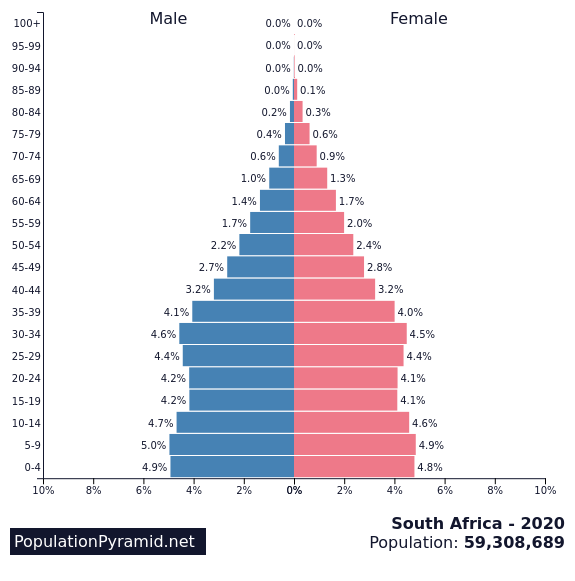South Africa
A few indicators to better understand the situation
In a nutshell
South Africa is the world’s twenty-fifth largest country -about twice the size of France- located in the far south of the African continent. It encircles the enclave of Lesotho, borders Namibia, Botswana and Zimbabwe to the north and Mozambique and Eswatini (formerly Swaziland) to the east and northeast. The country has a coastline of more than 2,500 kilometers. South Africa contains very diverse climate zones due to its varied topography and the influence of the two oceans that surround it on 3 sides: from extreme desert terrain on the border with Namibia to a lush subtropical climate along the East Coast and the border with Mozambique.
South Africa’s population is growing at an average rate of 1.5% per year and will number about 59 million by 2021. This makes it the most populous country in the Southern Hemisphere. This growth is expected to decline gradually over the next few decades. About 80% of South Africans are of black African descent. The South African population is extremely young: just over a quarter of residents are under the age of 15, 54% are under 30 and less than 10% of the population is over 60.

South Africa has three capitals, strategically scattered around the country. In 1910, when the Union of South Africa was formed, there was great disagreement over the location of the new country’s capital. A compromise was reached to spread power across the country and this led to the three different capitals: Pretoria is the administrative capital where the government and president are based, parliament is in Cape Town and the Supreme Court in Bloemfontein. Johannesburg is the economic center and also the country’s largest city with a population of just under 6 million. Two-thirds of the population lives in urban areas, compared to 50 percent in the early 1990s.
South Africa is a multiethnic society with a wide variety of cultures, languages and religions. Its pluralistic composition is reflected in the constitution’s recognition of 11 official languages, the fourth highest number in the world. The two most widely spoken languages are Zulu and Xhosa, followed by Afrikaans and English.
For more than 40 years, South Africa suffered from apartheid politics, where the black majority was oppressed and discriminated against by a white minority. Demonstrations were bloodily stifled and the situation escalated during the 1980s when the population revolted against the white minority government. In the early 1990s, the end of apartheid was negotiated and in 1994 democratic elections were organized for the first time and a government of national unity was formed under the leadership of Nelson Mandela, who was imprisoned on Robben Island for more than 25 years during the apartheid regime.
The African National Congress (ANC) has dominated politics in South Africa since the end of apartheid in 1994. Under the leadership of Archbishop Tutu, a Truth and Reconciliation Commission was established with the main goal of preaching forgiveness and healing the emotions, hatred and wounds caused by the apartheid system. The following years were quite chaotic but violence gradually subsided. Corruption and protest, however, continued to hang over the fledgling democracy like a shadow. Corruption scandals forced two-time president Jacob Zuma to resign in 2018.
Better...
The health of the average South African has improved well since the abolition of the apartheid regime. Overall life expectancy has increased from 55 years in 2000 to 64 years in 2021 (albeit with a big dip in the early 2000s due to the AIDS epidemic). Over the same period, infant mortality for children under five has declined from 8% to just over 3%.
3 in 4 adults over the age of 25 have some form of secondary education, up from 55% in 2000. A child starting school today in South Africa can expect to do so for the next 14 years, and the adult literacy rate there is just under 90%. Despite huge investments, however, the quality of education remains mostly inadequate. In many regions, for example, half the children do not have their own textbooks.
South Africa has a highly developed economy (the second largest in Africa after Nigeria) and advanced infrastructure. It is one of the world’s largest exporters of gold, platinum and other commodities and also has a well-developed financial, legal, communications, energy and transportation sectors and the continent’s largest stock exchange. Gross Domestic Product per capita is relatively high compared to other countries in Sub-Saharan Africa. Finally, since 2000, the relative number of people living in extreme poverty has almost halved, from 34.8% to 18.9%. Although this is still far too high, South Africa is among the better countries on the African continent in this regard.
But...
Although poverty rates have fallen significantly, South Africa remains one of the most unequal societies in the world. The difference between rich and poor is immense. Thousands of shacks stand in the shadow of stately multimillion-dollar properties with incredible ocean views. The richest 10 percent earn more than 50 percent of incomes. 55.5% Of the population still live below the national poverty line. 25 years after the abolition of apartheid, this inequality still largely follows the racial fault line between white and black.
This inequality is also evident among the very young. One in four children under five is growth retarded and, in stark contrast, one in eight suffers from obesity. Severe acute malnutrition is one of the three leading causes of child mortality, and the number of children who are malnourished and overweight is steadily increasing.
In a survey of the population in 2019 (Citizensurveys), in addition to poverty, skyrocketing unemployment, crime and corruption were highlighted as the biggest problems facing the country.
Since 1990, the unemployment rate has fluctuated between 25 and 30%. Among young people between the ages of 15 and 24, it is even more than 59%. Such high inequality and unemployment rates translate into high crime rates. According to Numbeo’s Crime Index, based on residents’ perceptions of safety in a country or city (not actual crime statistics), South Africa is the third most dangerous country in the world (after Venezuela and Papua New Guinea). Four South African cities even rank in the top 10 most dangerous cities. Not surprisingly, there are more private security guards in South Africa than police and army men combined. In addition, corruption grows rampant, right up to the highest levels. It has left a trail of destruction in almost all public institutions and, along with mismanagement and inefficiency, has left many public hospitals, police departments and other basic services on the brink of collapse.
Finally, the South African population suffers from several serious health problems. In addition to the malnutrition problems mentioned earlier, South Africa, along with Nigeria, is the country most severely affected by the AIDS epidemic. More than 180,000 people have died from it since its outbreak in the early 1980s. Currently, 20 percent of 15- to 49-year-olds carry the HIV virus, as do 240,000 children under the age of 14. As if this were not enough, South Africa has the highest incidence of tuberculosis worldwide (834 cases per 100,000 population).
And now?
South Africa has successfully ended apartheid, established a democratic government and avoided the mass chaos that has plagued other African countries making the transition from colonial to democratic control. The country has Africa’s most diversified and industrialized economy but has experienced several years of low growth due to factors such as low commodity prices, weak investor confidence, high policy uncertainty and rigid local labor markets. The impact of COVID-19 is likely to further contribute to this low growth pattern.
The country faces significant challenges such as addressing poverty, social inequality, unemployment and unequal access to land ownership (a particularly sensitive issue) and public services -problems that disproportionately affect the black population. There are still millions of people who go to bed on an empty stomach, children who do not receive a quality education and large groups of adults and youth who have no prospects of employment. This situation is fragile. The challenge will be to continue to improve economic and political conditions so that the country’s wealth can be better distributed among its people. Only then will South Africa be able to be considered an example for the rest of Africa.
